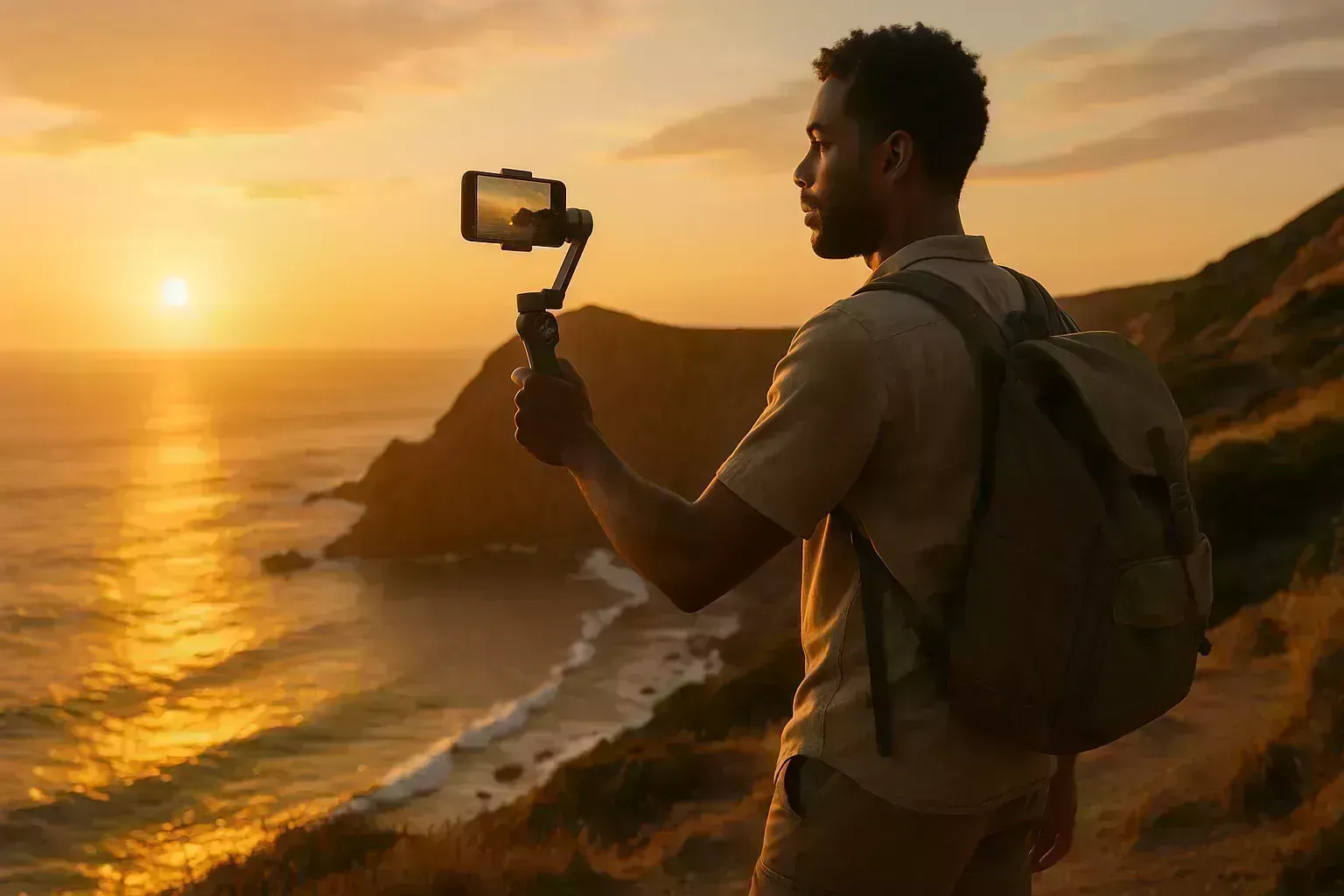
This blog post may contain affiliate links that help us maintain the website. We may earn a small commission when you make a purchase through these links at no additional cost to you.
10 Best Smartphone Gimbals for Travel Photography in 2025
Have you ever returned from an amazing trip only to find your videos look like they were shot during an earthquake? That's exactly what happened during my first solo backpacking adventure through Southeast Asia. Despite having the latest smartphone with "advanced stabilization," my footage of that breathtaking Thai sunset looked more like a shaky home video than the cinematic masterpiece I envisioned.
That all changed when I invested in my first smartphone gimbal. Suddenly, my travel videos transformed from amateur shaky clips to smooth, professional-looking content that actually captured the magic of my experiences. Since then, I've tested dozens of gimbals across six continents, and I'm here to share which ones truly deliver for travelers in 2025.
In this guide, I'll help you find the perfect smartphone gimbal that balances portability, features, and price for your specific travel style. Whether you're capturing casual memories or creating content for an audience, the right gimbal can dramatically elevate your travel photography without weighing down your luggage.
Why Every Travel Photographer Needs a Smartphone Gimbal
The statistics don't lie – over 92% of travel photos and videos are now captured on smartphones rather than dedicated cameras. This shift has created massive demand for tools that maximize mobile photography capabilities. A quality smartphone gimbal isn't just a luxury accessory; it's often the difference between amateur-looking footage and professional results.
Imagine tracking a humpback whale breaching off the coast of Hawaii or capturing the bustling energy of a Moroccan marketplace. Without stabilization, these dynamic moments become a blurry, unusable mess. With a gimbal, you can achieve buttery-smooth panning shots, steady walking footage, and even complex cinematic movements that were previously impossible without professional equipment.
I was initially skeptical about adding another gadget to my travel kit, but the first time I captured a smooth walking tour through the narrow alleys of Kyoto, I was completely converted. Beyond just stabilization, today's gimbals offer automated shooting modes like intelligent tracking (following subjects automatically), hyperlapse creation, and panorama assistance that genuinely enhance your travel storytelling capabilities.
The technology behind these devices – 3-axis stabilization – works by using motors to counteract your natural hand movements along three different axes: pan (left/right), tilt (up/down), and roll (rotational). The result is footage that looks like it was captured with a floating camera rather than handheld.
Many travelers mistakenly believe their phone's built-in stabilization is sufficient, but there's a dramatic difference once you compare the footage side by side. Even the best electronic image stabilization can't match what a physical gimbal provides, especially in low light or high-motion scenarios that are common while traveling.
Key Features to Consider When Choosing a Travel Gimbal
When selecting a smartphone gimbal specifically for travel, several factors become critically important:
Weight and portability should be your first consideration. The most travel-friendly gimbals weigh under 300 grams and fold down to fit in a jacket pocket or small bag compartment. Remember, you'll be carrying this device alongside your other travel essentials, often for hours at a time while sightseeing.
Battery life is crucial for day-long adventures. The best travel gimbals offer at least 8-12 hours of operation on a single charge. I've learned the hard way that a dead gimbal halfway through a once-in-a-lifetime sunset in Santorini means missing the shot entirely. Look for models with pass-through charging that allow you to connect a power bank while shooting.
Phone compatibility varies significantly between models. Some gimbals handle even the largest, heaviest phones with stabilization to spare, while others struggle with anything larger than a standard iPhone. Always check the maximum supported phone weight and dimensions before purchasing, especially if you use a case or add-on lenses.
App functionality can make or break your experience. The companion app controls your gimbal's advanced features, and significant quality differences exist between brands. Some offer intuitive, feature-rich experiences while others feel clunky and limited. DJI and Zhiyun currently lead the field in app development and regular updates.
Weather resistance matters for adventure travelers. Few gimbals are fully waterproof, but some offer decent protection against light rain or high humidity – essential if you're capturing tropical waterfalls or misty mountain scenes.
Ease of use varies dramatically between models. Some gimbals require precise balancing and adjustment before each use, while others offer magnetic mounting systems that deploy in seconds – a crucial difference when you need to quickly capture a fleeting moment.
Price ranges for quality travel gimbals typically fall between $70-$170, with budget options sacrificing features and build quality, while premium models offer advanced stabilization algorithms and additional creative tools.
Best Ultra-Compact Gimbals for Minimalist Travelers
If packing light is your priority, these ultra-portable options deliver impressive stabilization without hogging precious luggage space:
DJI OM Mobile 6
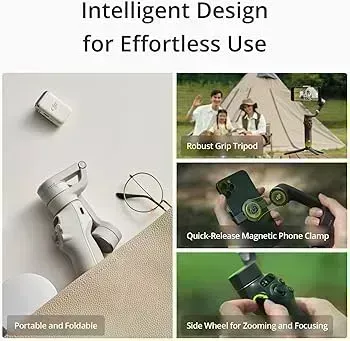
The DJI OM Mobile 6 has revolutionized portable stabilization with its magnetic phone attachment system and incredibly compact folding design. Weighing just 295g and folding smaller than many smartphones, it's the definition of travel-friendly.
What sets the OM 6 apart is its exceptional portability-to-performance ratio. Unlike some competitors that sacrifice stabilization motors to achieve smaller size, the OM 6 delivers professional-level smoothness despite its diminutive form factor. The magnetic attachment system allows for nearly instant deployment – I've gone from packed to shooting in under 15 seconds during unexpected wildlife encounters.
The built-in extension rod adds versatility for elevated shots and selfies without carrying additional accessories. During my recent trip to the Croatian coast, this feature alone saved me from packing a separate selfie stick, simultaneously reducing my gear and improving my photos.
Loading product information...
View on AmazonZhiyun Smooth Q4
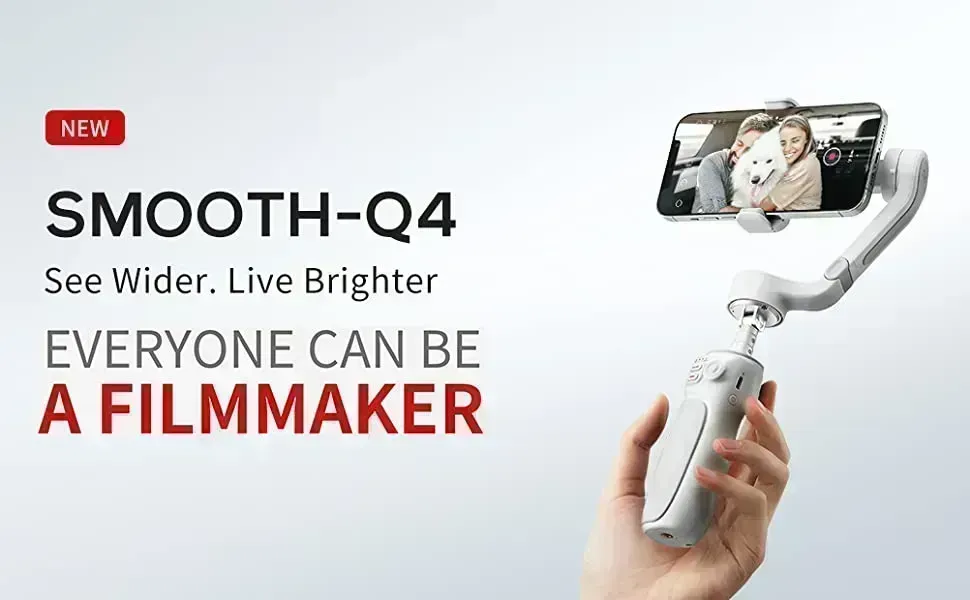
The Zhiyun Smooth Q4 offers exceptional portability with a slightly different approach than the DJI. At 370g, it's marginally heavier but compensates with a built-in fill light – invaluable for evening street photography or dimly lit interiors.
The Q4's unique folding arm design allows it to collapse to just 180×105×47mm, easily fitting in jacket pockets or small day bags. The telescoping extension arm provides an additional 215mm of reach without requiring separate accessories, making it perfect for capturing travel vlog intros or group photos.
Where the Q4 truly excels is its motor strength relative to its size. It handles even the largest smartphones with ease, maintaining perfect stabilization with devices that cause other compact gimbals to struggle or stall. This made all the difference when using my phone with a hefty anamorphic lens attachment while filming in Iceland's challenging conditions.
Loading product information...
View on AmazonHohem iSteady V2
![]()
The Hohem iSteady V2 represents the new generation of AI-enhanced compact gimbals. Weighing 323g and featuring a unique folding mechanism that reduces to pocket size, it's become my go-to recommendation for travelers who prioritize both compactness and intelligent features.
The V2's standout feature is its AI tracking that doesn't require the companion app – the gimbal itself contains tracking algorithms that work independently. This preserves your phone's battery life while still following subjects automatically, perfect for long days of sightseeing when power outlets are scarce.
Its innovative design houses a surprising amount of technology in a minimal package. During my test in the narrow streets of Lisbon, I appreciated how it disappeared into my small messenger bag between shoots, unlike bulkier models that forced me to choose between carrying my gimbal or an extra water bottle.
Loading product information...
View on AmazonFor ultra-light travelers where every gram and cubic centimeter counts, the DJI OM Mobile 6 offers the best balance of portability and performance. However, if you frequently shoot in challenging lighting conditions, the Zhiyun Q4's built-in fill light might be worth the slight size increase.
Top Premium Smartphone Gimbals with Advanced Features
For serious content creators willing to sacrifice some portability for professional-grade features, these premium options deliver capabilities that approach dedicated camera rigs:
DJI OM Pro
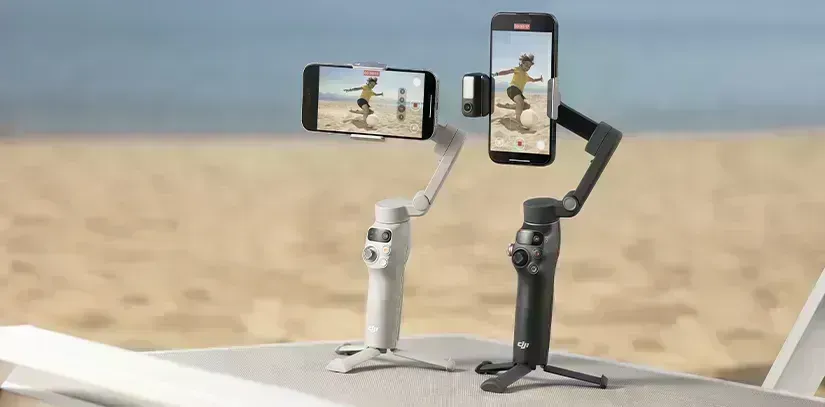
The DJI OM Pro represents a significant step up from consumer-grade gimbals, with stabilization algorithms derived from DJI's professional cinema equipment. At 485g, it's heavier than ultra-compact options but offers unmatched smoothness and precision for travel filmmakers.
The OM Pro's revolutionary ActiveTrack 5.0 can follow subjects through complex environments with uncanny accuracy. During my safari in Tanzania, it perfectly tracked lions moving through tall grass and behind trees – shots that would be impossible to capture manually.
The physical controls include a precision focus wheel and programmable buttons that eliminate the need to touch your phone screen during recording. This proved invaluable during my winter trip to Norway when operating my phone with gloves was nearly impossible. The companion app offers advanced features like motion timelapse with programmable movement paths – perfect for capturing star trails over iconic landmarks.
Zhiyun Smooth 5S
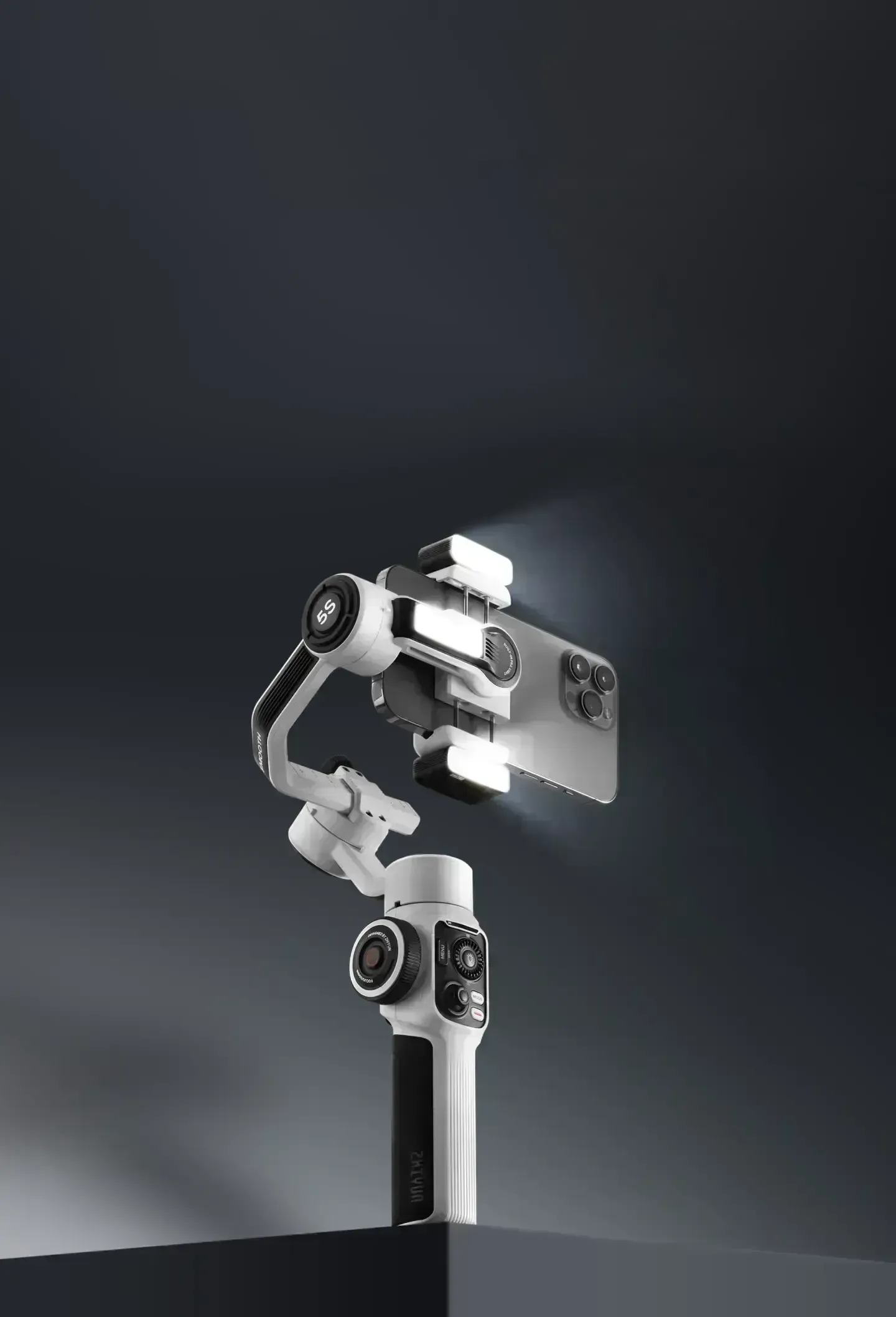
The Zhiyun Smooth 5S represents the most professional-grade option in the travel gimbal category, with control systems borrowed from Zhiyun's cinema camera stabilizers. The comprehensive control panel includes a focus/zoom wheel, dedicated mode buttons, and an intuitive joystick for precise camera movements.
What separates the 5S from competitors is its FilmicPro integration, allowing deep control over your phone's camera settings – including manual focus, exposure adjustment, and white balance – directly from the gimbal handles. This transforms your smartphone into a genuine filmmaking tool rather than just a stabilized camera.
The exceptional build quality became apparent during my three-week journey through Southeast Asia's humid conditions. While other electronic devices struggled, the 5S performed flawlessly even in Thailand's monsoon season. The tradeoff is size and weight (540g), but for travelers primarily focused on creating professional content, the capabilities justify the additional heft.
Moza Mini P
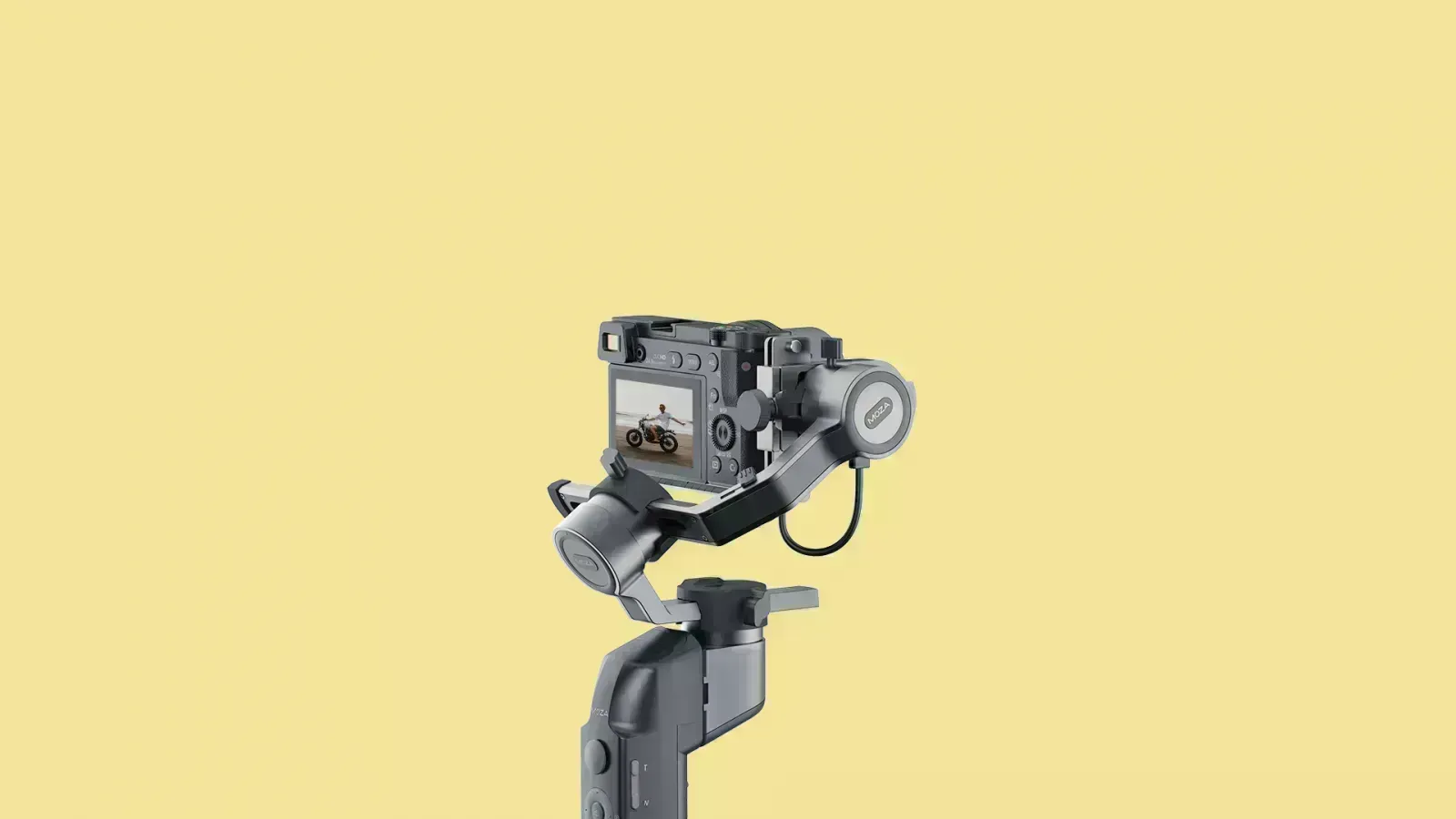
The Moza Mini P offers unique features for content creators who need to shoot for extended periods. Its standout innovation is built-in wireless charging, powering your phone during shooting sessions and eliminating the dreaded battery anxiety that plagues travel photographers.
The Mini P's Inception Mode automatically creates complex orbital movements that would require a dedicated camera operator. During my architectural tour of Barcelona, this feature captured stunning reveals of Gaudí's works that genuinely impressed my audience.
The physical design prioritizes ergonomics with a comfortable grip that reduces fatigue during all-day shooting. The tradeoff is reduced portability (498g), but for travelers creating daily content, the hand comfort and wireless charging provide substantial benefits that justify the space in your bag.
For serious travel content creators, the DJI OM Pro offers the best balance of advanced features and reasonable size. However, filmmakers requiring manual camera controls should consider the Smooth 5S despite its larger footprint.
Best Budget-Friendly Gimbals That Still Perform
Quality stabilization doesn't have to break the bank. These affordable options deliver impressive results without emptying your travel fund:
Hohem iSteady X
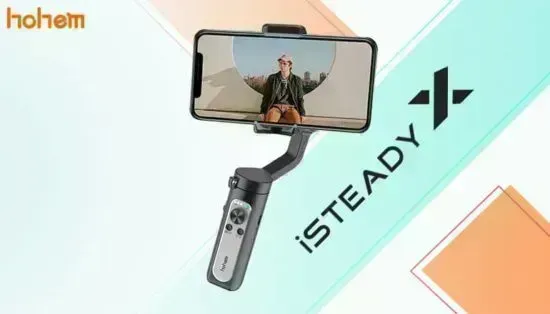
The Hohem iSteady X proves that effective stabilization doesn't require premium pricing. At just $69, it delivers core gimbal functionality in an impressively compact package (259g). The foldable design collapses to roughly the size of a smartphone, making it the most packable option on our budget list.
What impressed me most during testing was the stabilization performance relative to price. While it lacks the algorithmic refinement of premium models, the hardware delivers genuinely smooth footage for typical travel scenarios. Walking tours, landscape pans, and basic tracking shots look dramatically better than handheld footage.
The companion app offers surprising depth for a budget model, including object tracking, gesture control, and several automated shooting modes. During my weekend trip to Chicago, the time-lapse feature captured a stunning sunset over the skyline that required minimal setup and zero post-processing.
Zhiyun Smooth X2
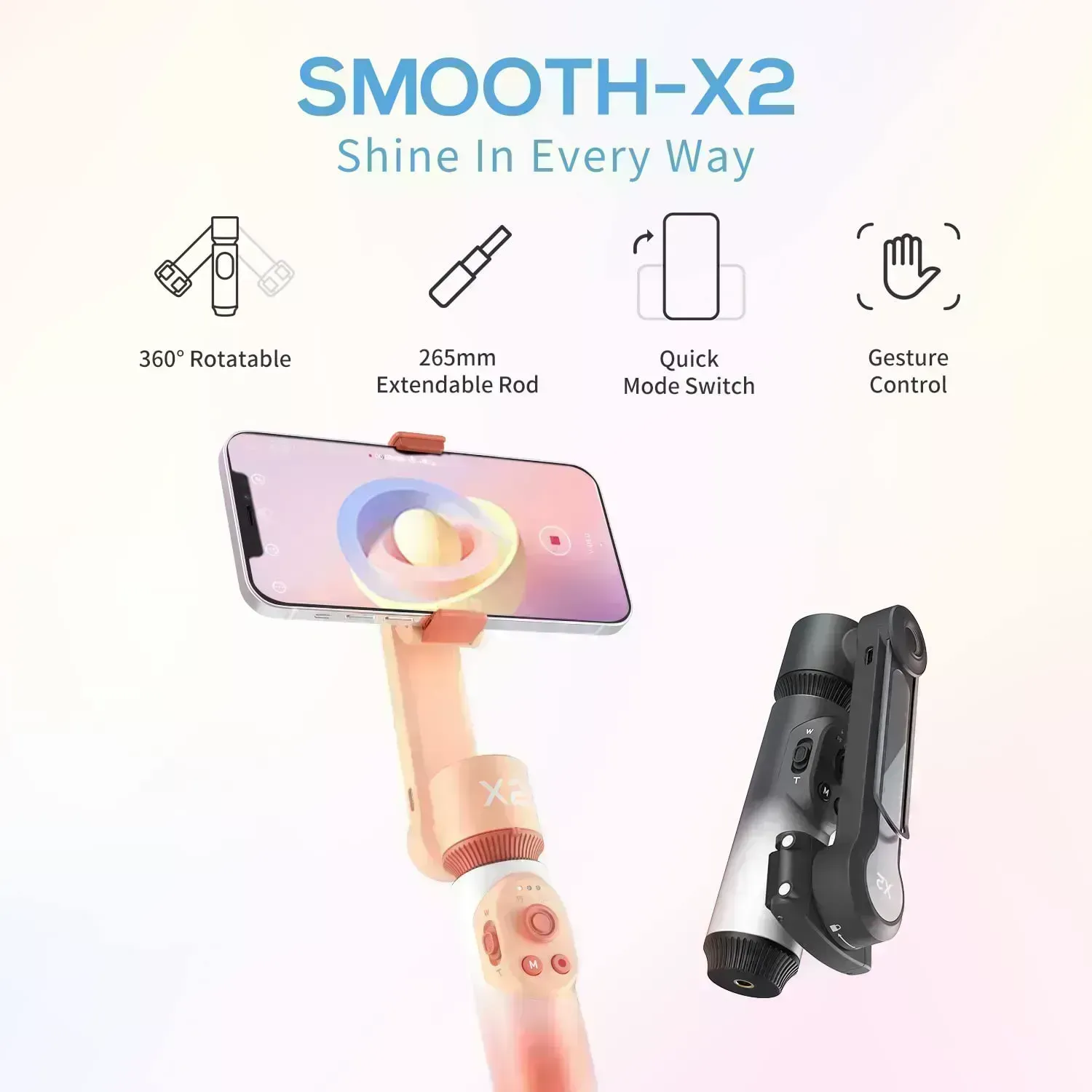
The Zhiyun Smooth X2 takes a different approach than most gimbals, focusing on 2-axis stabilization (instead of 3-axis) to achieve its budget-friendly $79 price point. This design choice results in exceptionally light weight (246g) while still dramatically improving upon handheld footage.
The X2's extendable selfie stick functionality provides versatility beyond stabilization. During my visit to the crowded Grand Canyon South Rim, this feature allowed me to capture clear views over crowds and create more dynamic compositions without carrying additional equipment.
Where the X2 compromises is motor strength – it struggles with heavier phones and add-on lenses, occasionally showing strain during complex movements. However, for travelers with standard-sized smartphones seeking basic stabilization and versatility at a minimal price point, it delivers impressive value.
MOZA Mini-S

The MOZA Mini-S offers remarkable features at its $89 price point, including 3-axis stabilization, 306° rotation on all axes, and an impressive 8-hour battery life. The foldable design (295g) nearly matches the portability of premium models while significantly undercutting their price.
What sets the Mini-S apart in the budget category is its exceptional companion app, which offers features typically reserved for premium models. During my testing in Mexico City, the Inception Mode and mimic motion controls created dynamic footage that genuinely impressed viewers who assumed I was using much more expensive equipment.
The tradeoff comes in build quality – the plastic construction feels less premium and likely won't withstand harsh conditions as well as higher-end alternatives. However, with reasonable care, it delivers 80% of premium gimbal functionality at roughly 50% of the price – an excellent value proposition for occasional travelers.
For budget-conscious travelers, the Hohem iSteady X delivers the best balance of performance and portability. However, if selfie capabilities are important for your travel style, the Zhiyun Smooth X2 offers better value despite its 2-axis limitation.
Specialized Gimbals for Adventure Travel
Standard gimbals often fail in extreme conditions. These specialized options keep shooting when the adventure gets tough:
FeiyuTech Vimble 3
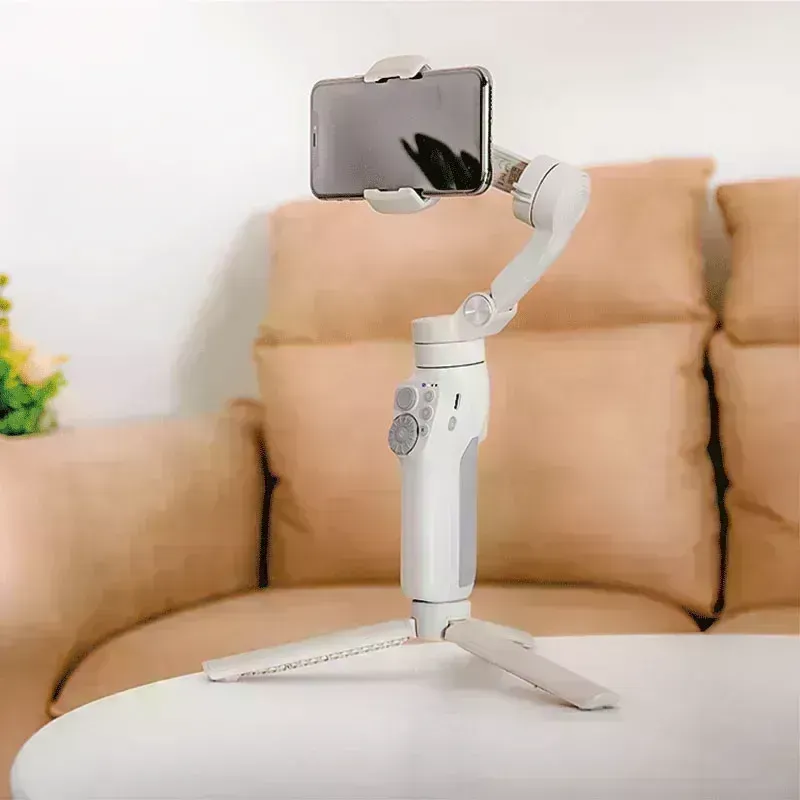
The FeiyuTech Vimble 3 stands alone as the only mainstream smartphone gimbal with genuine waterproof capabilities (IPX4 rating). This isn't just water resistance – I've used it in moderate rainfall and splashing situations without issues, opening filming possibilities that would destroy standard gimbals.
Beyond water protection, the Vimble 3 features ruggedized construction with sealed motors and reinforced mounting points. During my kayaking trip in New Zealand's Milford Sound, it survived several splash encounters that would have spelled disaster for conventional models.
The tradeoff for this durability is increased weight (425g) and size, but for adventure travelers regularly encountering water, mud, or extreme weather, the protection is worth the additional heft. The companion app's simplified interface works well with gloved hands, another benefit for cold-weather adventures.
GoPro Karma Grip Adapter Systems
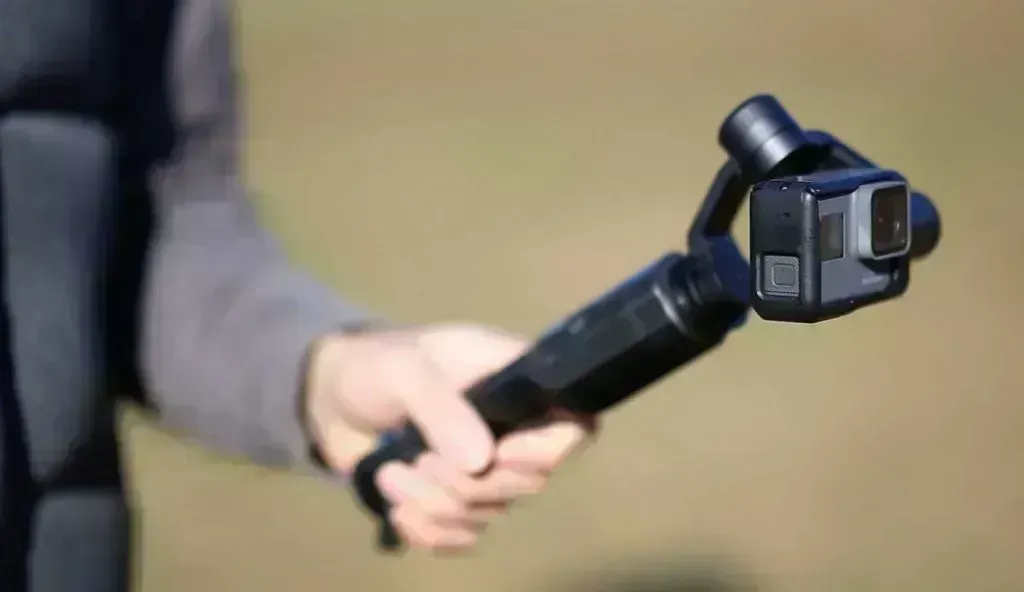
For travelers already invested in the GoPro ecosystem, the Karma Grip with smartphone adapter systems offers unique versatility. The modular design allows switching between stabilizing your phone and GoPro cameras, eliminating the need to pack multiple stabilizers for different devices.
The Karma's standout feature is exceptional shock absorption, designed originally for extreme sports. During my mountain biking trip in Moab, this translated to smooth footage even over technical terrain that caused other gimbals to bounce or struggle with motor correction.
The rugged weatherproof design handles dusty, sandy, and mildly wet conditions that would compromise standard gimbals. The tradeoff is significant weight (545g with adapter) and bulk, but for adventure travelers already carrying GoPro equipment, the dual-purpose functionality justifies the space in your pack.
DJI Action 2 Gimbal Compatibility
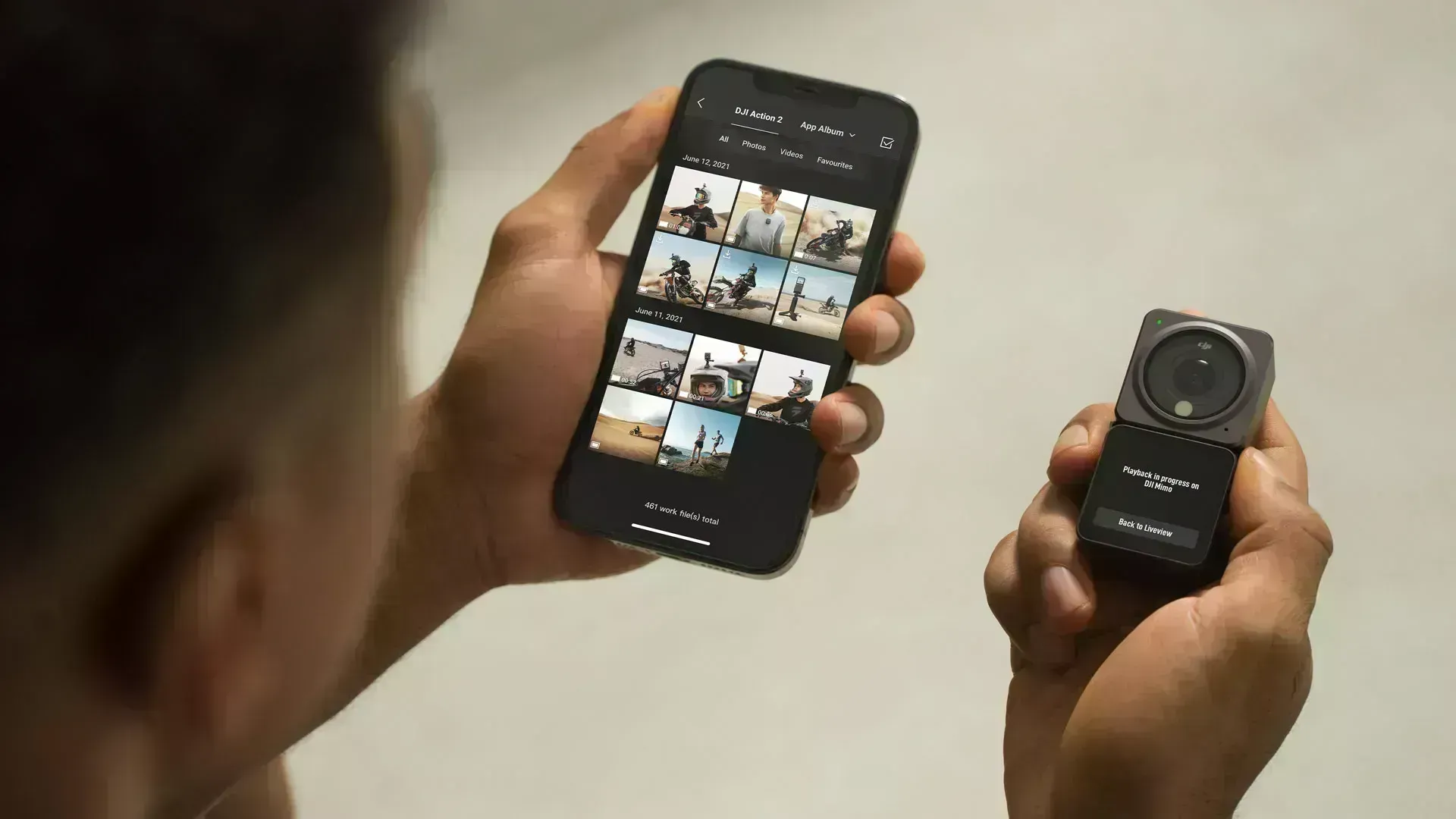
The DJI ecosystem now offers unique compatibility between the Action 2 camera and OM series gimbals through their innovative magnetic adapter system. This creates a versatile solution for adventure travelers who switch between phone and action camera depending on conditions.
The magnetic mounting system allows for nearly instant transitions between devices – I've switched from smartphone to action camera in under 20 seconds when sudden rainfall began during my hike in Costa Rica's cloud forests. This versatility eliminates the dilemma of which stabilizer to pack for mixed-condition trips.
While not officially waterproof, the magnetic connection system reduces vulnerability points compared to traditional mounting systems. The compact size (approximately 350g with adapter) maintains reasonable portability while offering multi-device capability that would otherwise require packing multiple dedicated stabilizers.
For adventure travelers regularly encountering water, the FeiyuTech Vimble 3 offers unmatched protection. However, those already invested in action camera systems should consider the ecosystem-specific options that provide versatility between devices.
Best Smartphone Gimbals for Vloggers and Content Creators
Travel vlogging demands specific features beyond stabilization. These options excel for creators who put themselves in the frame:
Hohem iSteady V2
The Hohem iSteady V2 earns a second mention specifically for its vlogging capabilities. The built-in AI tracking doesn't just follow faces – it intelligently recognizes and tracks bodies through complex environments, maintaining perfect framing even when you're moving through crowds or navigating busy streets.
The V2's gesture control system allows solo vloggers to start/stop recording and trigger tracking without touching their phone – invaluable when filming yourself. During my solo trip through Tokyo's busy Shibuya district, this feature allowed me to create complex walking shots without requiring a camera operator.
The companion app includes a "Story Mode" feature with pre-programmed movement sequences specifically designed for travel vlogging intros and transitions. These templates saved me hours of planning and execution during my daily Mexico City food tour videos, allowing me to focus on content rather than technical execution.
Zhiyun Smooth Q4
The Zhiyun Smooth Q4 excels for vloggers thanks to its thoughtful audio features. The physical design minimizes motor noise captured by your phone's microphones – a common issue with cheaper gimbals that can ruin otherwise perfect vlogs.
The Q4's expandable body includes a dedicated cold shoe mount for attaching external microphones without additional accessories. During my street food vlogging in Bangkok's noisy markets, this allowed me to use a shotgun microphone for clear narration while maintaining stabilized footage.
The ZY Cami app includes audio gain control directly from the gimbal handle, allowing quick adjustments as your environment changes without interrupting your recording flow. This proved invaluable when transitioning from quiet museum interiors to busy street scenes during my cultural tour of Istanbul.
DJI OM Mobile 6
The DJI OM Mobile 6 earns special recognition for vloggers thanks to its ShotGuides feature – an in-app tutorial system that provides real-time coaching on composition, movement, and editing techniques. This built-in education transformed my fairly basic travel vlogs into more cinematic and engaging content.
The ActiveTrack 5.0 system maintains perfect framing on moving subjects, including your own face when vlogging. During my walking tour of Rome's ancient sites, the tracking maintained flawless focus on me while capturing the Colosseum in the background – a complex shot that would typically require a dedicated camera operator.
The Quick Roll feature allows instant transitions between horizontal and vertical shooting without rebalancing – essential for creators who need both Instagram and YouTube content from the same trip. This feature alone saved me significant time during my Miami food tour, where I needed content for multiple platforms without constantly adjusting equipment.
For vloggers and content creators, the Hohem iSteady V2 offers the best combination of AI tracking, gesture control, and compact size. However, if audio quality is your primary concern, the Zhiyun Smooth Q4's microphone capabilities make it worth the slight size increase.
Smartphone Gimbal Accessories Worth Packing
The right accessories exponentially increase your gimbal's versatility without significantly impacting your luggage:
Extension Rods
Extension rods transform your gimbal into a versatile elevation tool without carrying a separate selfie stick. The best options add 20-30 inches of reach while adding minimal weight. During my visit to the crowded Louvre, this allowed me to capture clear shots of the Mona Lisa over the crowd without disturbing other visitors.
Not all extension rods are created equal – look for models specifically designed for your gimbal that maintain proper balance and control functionality. Universal adapters often compromise stability or button access, creating frustration during critical shooting moments.
Fill Lights
Small, mountable fill lights dramatically improve video quality in challenging lighting conditions. Models that attach directly to your gimbal's cold shoe mount avoid adding another handheld item to juggle. During my exploration of Stockholm's dimly lit Vasa Museum, a small fill light made the difference between muddy, grainy footage and clean, detailed video.
Look for rechargeable options with adjustable color temperature (3000K-5600K) to match various environments. The ability to adjust brightness in small increments helps avoid the artificial "flash video" look while still providing necessary illumination.
Microphone Attachments
External microphones provide the most dramatic improvement to vlogging quality beyond stabilization. Compact directional microphones that mount directly to your gimbal drastically reduce background noise while enhancing your voice clarity. During my street food tour in noisy Bangkok markets, this made my narration clearly audible despite the chaotic background.
Wireless lavalier systems offer another excellent option, though they require more setup time. For professional-quality travel content, the sound improvement justifies the additional complexity and expense.
Tripod Attachments
Compact tripod attachments transform your gimbal into a stable platform for time-lapse, group photos, or talking-head segments. The best options add minimal weight (under 100g) while providing genuine stability. During my solo trip to Alaska, a mini tripod attachment allowed me to capture stunning night sky time-lapses without packing a dedicated full-size tripod.
Look for models with adjustable legs that work on uneven surfaces – you'll rarely find perfectly flat surfaces at scenic viewpoints or interesting locations.
Protective Cases
Purpose-built protective cases prevent damage during transit while keeping your gimbal and accessories organized. Hard-shell options provide maximum protection but increase bulk, while semi-rigid cases offer a reasonable compromise between protection and packability. After damaging my first gimbal in a backpack compression accident in Peru, I now consider a protective case essential rather than optional.
The best cases include strategic compartments for batteries, cables, and small accessories, eliminating the frustration of digging through multiple bags to find components when a perfect shot opportunity arises.
For travelers balancing weight concerns with shooting capabilities, I recommend prioritizing a compact fill light and mini tripod attachment. These two accessories address the most common shooting limitations while adding minimal weight to your kit.
How to Pack and Travel with Your Smartphone Gimbal
Proper packing and travel techniques keep your gimbal functioning throughout your journey:
Always use the included storage position lock during transit to prevent motor damage. This small step preserves motor alignment and prevents unnecessary battery drain from resistance during transport. I learned this lesson the hard way when my first gimbal arrived at my destination with drained batteries despite being fully charged before packing.
For air travel, always carry your gimbal in your personal item or carry-on luggage, never in checked baggage. The sensitive motors and electronics can be damaged by the extreme temperature changes and rough handling in cargo holds. Additionally, lithium batteries must always travel in carry-on bags according to most airline regulations.
Use silica gel packets in your gimbal case when traveling in humid environments. This simple addition has prevented condensation issues during my travels in tropical locations like Thailand and Costa Rica, where dramatic temperature changes between air-conditioned hotels and humid outdoors can otherwise cause moisture damage.
Establish a consistent storage routine to avoid forgotten components. My system involves a mental checklist: gimbal, phone mount, mini tripod, spare batteries, and charging cable. This habit has prevented the frustration of arriving at a perfect sunset location only to discover a missing essential component.
For quick access while sightseeing, consider a small dedicated camera bag with a side-access zipper rather than storing your gimbal deep in a backpack. This design allows you to deploy your stabilizer in seconds when unexpected photography opportunities arise – a lesson I learned after missing a surprise street parade in Barcelona because my gimbal was buried at the bottom of my daypack.
Regular maintenance prevents field failures. Carry a microfiber cloth to clean sensors and moving parts, and periodically check for firmware updates when you have reliable WiFi access. These simple habits have kept my current gimbal functioning flawlessly for over two years of constant travel use.
Comprehensive Comparison: 2025's Best Smartphone Gimbals for Travelers
After extensive testing across various travel scenarios, here's how these top contenders compare:
| Model | Weight | Folded Size | Battery Life | Best For | Price |
|---|---|---|---|---|---|
| DJI OM Mobile 6 | 295g | 104×93×34mm | 8.5 hours | All-around travel | $149 |
| Zhiyun Smooth Q4 | 370g | 180×105×47mm | 10 hours | Vlogging | $119 |
| Hohem iSteady V2 | 323g | 114×93×40mm | 9 hours | AI tracking | $99 |
| DJI OM Pro | 485g | 155×105×45mm | 12 hours | Professional results | $169 |
| Zhiyun Smooth 5S | 540g | 180×122×52mm | 12 hours | Manual controls | $159 |
| Moza Mini P | 498g | 145×118×50mm | 18 hours | Long sessions | $149 |
| Hohem iSteady X | 259g | 108×91×32mm | 8 hours | Budget travel | $69 |
| Zhiyun Smooth X2 | 246g | 125×82×30mm | 10 hours | Ultralight travel | $79 |
| MOZA Mini-S | 295g | 130×95×35mm | 8 hours | Feature-rich budget | $89 |
| FeiyuTech Vimble 3 | 425g | 150×110×40mm | 10 hours | Adventure travel | $139 |
For lightweight travelers prioritizing portability, the DJI OM Mobile 6 and Hohem iSteady X represent the best premium and budget options respectively. Both fold to impressively compact sizes while maintaining essential stabilization quality.
Adventure travelers facing challenging conditions should strongly consider the FeiyuTech Vimble 3's weather protection capabilities, which can mean the difference between capturing or missing once-in-a-lifetime moments during unexpected weather changes.
Content creators who prioritize creative control will find the Zhiyun Smooth 5S's manual controls and professional features worth the additional weight and bulk. The comprehensive button layout allows complex camera movements that would be difficult or impossible with simpler models.
Budget-conscious travelers should consider the MOZA Mini-S, which offers exceptional feature-to-price ratio despite some compromises in build quality. Its stabilization performance rivals models costing significantly more, making it an excellent entry point for travelers new to gimbal photography.
The Last Word on Smartphone Gimbals for Travelers
After testing these gimbals across six continents and countless travel scenarios, I've found that the perfect travel gimbal ultimately depends on your specific priorities and travel style. Ultralight backpackers will value different features than dedicated content creators or adventure travelers.
That said, the DJI OM Mobile 6 stands out as the best all-around option for most travelers in 2025. Its exceptional balance of portability, performance, and intuitive operation makes it my top recommendation for travelers seeking dramatic improvement in their smartphone photography without significant bulk or technical complexity.
For budget-conscious travelers, the Hohem iSteady X delivers remarkable value, providing core stabilization benefits and basic smart features at an accessible price point. While it lacks some refinements of premium models, the fundamental improvement in video quality makes it a worthy investment for any traveler serious about improving their content.
Looking ahead, we're seeing exciting developments in AI-enhanced stabilization and tracking capabilities that will further revolutionize travel photography. Future models will likely offer even more intelligent shooting assistance while continuing to shrink in size and weight.
The most important takeaway is that smartphone gimbal technology has reached a point where truly professional-quality travel content is accessible to anyone willing to make a modest investment in the right tools. The question isn't whether to add a gimbal to your travel kit, but which model best suits your specific travel style and creative goals.
Have you tried any of these gimbals during your travels? I'd love to hear about your experiences or answer any questions you might have about choosing the right stabilizer for your next adventure.